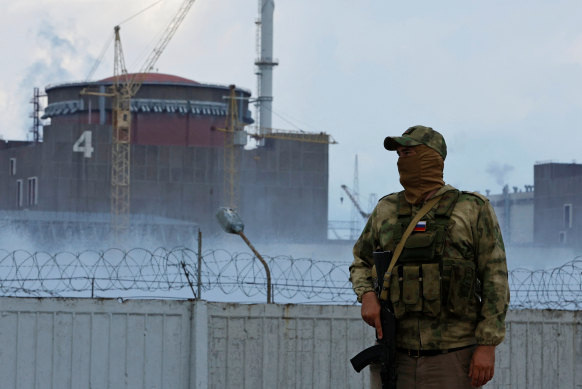‘Grey zone’ warfare exposes Western weaknesses, including in Australia

When first asked about the possibility that Russia might use nuclear weapons against his country, President Volodymyr Zelensky didn’t talk about bombs. He talked about a more immediate nuclear threat to Ukraine.
For months, Russia has been endangering the huge nuclear power plant at Zaporizhzhia in southeast Ukraine, and on the weekend it took a step closer to turning it into a radioactive bomb. The last remaining external electricity supply was cut by shelling near the plant, the biggest in Europe. The reactors need electric power to run their cooling systems. Without cooling, they will overheat and melt down in a fire that could spread radioactive fallout in whichever direction the wind is blowing.
IllustrationCredit:Dionne Gain
Europe and Russia – as well as Ukraine – would be at risk of catastrophe for their people as well as their crops, herds and farmlands in one of the world’s crucial food bowls.
For the moment, emergency diesel generators are supplying electricity to keep the reactors cool. But the diesel generators themselves have only 10 days fuel supply.
“The resumption of shelling, hitting the plant’s sole source of external power, is tremendously irresponsible,” said the International Atomic Energy Agency’s Director General, Rafael Grossi.
Even though the plant’s six reactors aren’t producing power at the moment, they still need cooling. Grossi said he’ll travel to Kyiv and Moscow in an effort to get agreement to create a no-shelling zone around the plant: “This is an absolute and urgent imperative.”
A Russian soldier stands guard at the Ukrainian Zaporizhzhia nuclear power plant.Credit:Reuters
Zelensky himself has been demanding such a zone for months, but Russia isn’t prepared to stop fighting. Even though Zaporizhzhia, where the plant is sited, is now in territory claimed by Russia as supposedly justified by Moscow’s dodgy referenda.
This is just one example of how civilian infrastructure is being targeted in this war, though it is by far the most hazardous one. Most such attacks, naturally, have been aimed at the two combatant nations. Ukrainian forces apparently struck a target of their own on the weekend. A portion of the Kerch Bridge connecting Russia to Russian-claimed Crimea was blown up.
The Russian-built bridge was opened by Vladimir Putin in person when he drove a truck across it for the cameras in 2018. It’s been used by Russia to resupply its forces invading Ukraine. The Ukrainians haven’t taken responsibility for the blast, although its post office issued a commemorative stamp with suspiciously swift alacrity.
Ukrainian authorities say that Russia has launched 4000 attacks on its transport infrastructure since it began the war. But the two combatant nations have not been the only targets of infrastructure warfare: The two big underwater Nordstream gas pipelines that were ruptured in the Baltic Sea a couple of weeks ago, for instance.
The pipes are designed to carry natural gas from Russia to Germany. They were blown up on the seabed of the exclusive economic zones of Sweden and Denmark. So the obvious suspect, Putin, was not attacking Ukraine but the interests of countries sympathetic to Ukraine.
It happened again on the weekend when Germany’s rail system was sabotaged. All train services of the state-owned Deutsche Bahn in northern Germany were suspended for about three hours after a fibre optic cable was cut in two places 550 kilometres apart, near-simultaneously.
Transport Minister Volker Wissing said the network had been hit by a “malicious and targeted act”. German police are investigating. It could be coincidental and not made-in-Moscow. Either way, Russia has launched cyberattacks on its neighbours including Estonia, Lithuania and Montenegro, all NATO members, since the beginning of the invasion.
In other words, you don’t need to be fighting a war to be targeted for infrastructure attack in “grey zone” tactics, or coercive state-based actions short of kinetic war. This includes trade embargoes, influence operations, maritime intimidation, and other practices to which Australia recently has been subjected by its major trading partner.
If Russia or China decided to wage infrastructure war against Australia, where might it strike? I asked half a dozen Australian experts from the fields of politics, defence and think tanks and every one of them cited undersea internet cables as the primary or secondary vulnerability.
Most of them ranked the cables first. “Our submarine cables are absolutely critical,” says the opposition defence spokesman, Andrew Hastie, formerly assistant minister for defence. “Knowing we are an island that relies on cables, it’s a great way to sever us from the rest of the world.”
About 95 per cent of Australia’s internet traffic flows through underwater fibre optic cables. While some cables connect to the near region, Australia is connected to a small number – around 10 – intercontinental cables that join it to the wider world. Most make landfall at Perth or Sydney beaches.
The director of the International Cyber Policy Centre, Fergus Hanson, says that “it’s not the end of the world if a cable gets snipped, but if you’re looking at it from a Ukrainian war-type perspective or a terrorism perspective, there’s a very high concentration of landing points and that’s where there’s extreme vulnerability”.
You might think the landing points are top secret. Many are not: “It’s one of the weird anomalies of the internet, a system built on trust, that’s surprisingly insecure for a system so central to everything we do,” he says.
Liberal Senator Jim Molan, a former major general who has campaigned for national resilience in recent years, makes the point that 80 to 90 per cent of Australia’s classified communications use the same submarine cables that carry routine civilian traffic.
They are encrypted yet just as vulnerable: “The US, China and Russia have specialist submarines designed to wreck undersea cables.”
There is an alternative, satellites, but they carry relatively small volumes of data. Malcolm Davis from the Australian Strategic Policy Institute makes the point that you don’t need a hot war for a hostile state to attack critical infrastructure: “China could attack the cables in peacetime and do it in a way that’s deniable and doesn’t justify a military response. They could interfere with satellites, interrupt downlinks.”
Putin’s war is full of important lessons for countries everywhere, especially ones with unprotected critical infrastructure.
The Opinion newsletter is a weekly wrap of views that will challenge, champion and inform your own. Sign up here.
Most Viewed in World
From our partners
Source: Read Full Article

